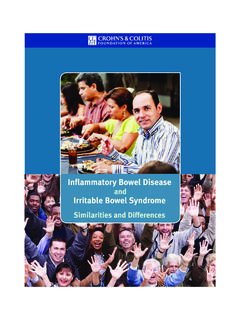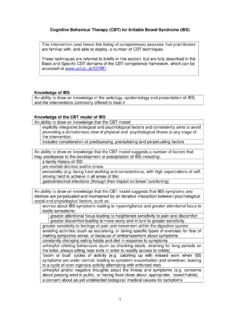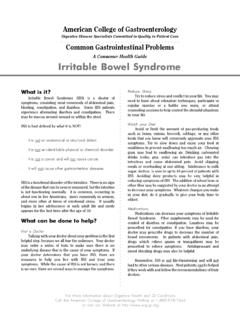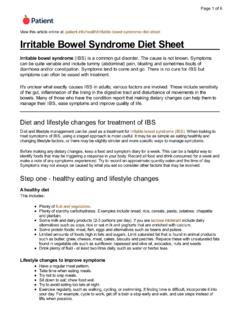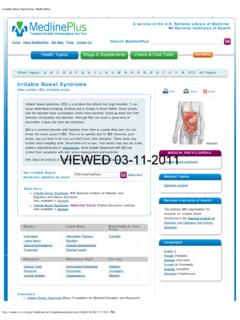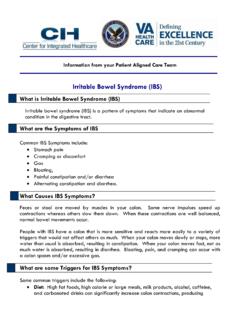Transcription of Irritable Bowel Syndrome Working Group
1 Working Group ParticipantsBackgroundRationale for Irritable Bowel Syndrome (IBS) Working Group (WG) IBS is one of the most commonly diagnosed GI disorders IBS lacks a standard fit-for-purpose PRO instrument for assessing important patient-experienced signs and symptoms of IBS PRO Consortium member representatives and FDA advisors identified IBS as a priority area for the development of a PRO instrumentGoal of the IBS WG To develop three PRO measures for patient-reported symptoms in IBS with constipation (IBS-C), IBS with diarrhea (IBS-D), and IBS with mixed symptoms (IBS-M) for use in clinical trials as a primary endpoint measure to establish treatment benefitTargeted Labeling Language Product X is indicated in adults for the treatment of symptoms associated with Irritable Bowel Syndrome [with constipation (IBS-C), with diarrhea (IBS-D), or mixed (IBS-M)] Product X improved abdominal symptoms (as measured by the abdominal symptom severity subscale) and Bowel movement-related symptoms (as measured by the BM-related symptom subscale).
2 Note: This indication would be supported by an improvement in both abdominal symptoms and Bowel movement-related symptomsConceptual Framework Example Endpoint Model for Treatment of IBS-M Irritable Bowel Syndrome Working GroupPresented at the Eighth Annual PRO Consortium Workshop Bethesda, MD April 26-27, 2017Ta r g e tPopulation US-based adult patients (18 years and older; males and non-pregnant females) Diagnosis of IBS of three main subtypes based on Rome III criteria ( , IBS-C, IBS-M, and IBS-D) Patients without known or suspected organic disorder ( , Crohn s disease) that would better explain symptoms Patients not concomitantly using medications known to affect GI mobility, constipation, or other IBS symptomsMilestonesEndpoint Hierarchy EndpointConcept(s)Endpoint TypePrimaryOverall response (TBD) indicating improvement in IBS-M symptom severity Improvement in abdominal symptoms (abdominal pain, discomfort, bloating, cramping) Improvement in selected BM-related symptoms (stool consistency, stool frequency, incomplete BMs, straining, recurrent BMs, urgency)PROB owel movement-related symptoms pertain to the following subtypes:* IBS-C.
3 +IBS-D; IBS-MWorking Group Updates Information Dissemination Fehnel, S. et al. Development of the Diary for Irritable Bowel Syndrome Symptoms (DIBSS) to Assess Treatment Benefit in Clinical Trials: Foundational Qualitative Research. Value in Health 2017;20(4):618-626 Develop manuscript based on quantitative pilot study resultsLessons Learned Consider developing hypothesized preliminary scoring algorithm prior to quantitative phase Plan appropriately with ePRO vendor for time and resources required for the development and review of the requirements document Develop scripts to be used in user acceptance testing (UAT) prior to distribution of devices for testing Include sufficient time and resources for UAT in project plan Collaboration with sponsors to identify experienced study sites in therapeutic area can greatly expedite the data collection processNextSteps Complete data analyses and review results from quantitative pilot study Prepare and submit Qualification Briefing Package Longitudinal clinical trial data will be analyzed for DIBSS-C by sponsor to support measurement properties in an IBS-C patient sample by Q2 2017 Company/OrganizationRepresentatives AllerganRobyn T.
4 Carson, MPH (Co-Chair); Steven J. Shiff, MDIronwood Pharmaceuticals, Hanlon, MPH (Co-Chair); David Reasner, PhDTakeda Pharmaceuticals InternationalMaria Claudia Perez, MD; Amy Duhig, PhD (Consultant- Xcenda)Nonmember ParticipantsAffiliationNancyNorton, BSInternational Foundationfor Functional Gastrointestinal Disorders (IFFGD)Expert Panel MembersAffiliationLin Chang, MDUniversity of California,Los AngelesWilliam D. Chey, MDUniversity of MichiganDouglas A. Drossman, MDUniversity of North Carolina, Chapel HillJeffrey M. Lackner, PsyDUniversity at Buffalo, SUNYB rian E. Lacy, MD, PhDDartmouth-Hitchcock Medical CenterContract Research OrganizationResearch TeamRTI Health SolutionsSheri Fehnel, PhD; Claire Ervin, MPH; Lori McLeod, PhD; Diana GossePRO System ProviderRepresentativeBracket GlobalAlisandra Johnson, BSAbdominal Pain *, +, Abdominal Discomfort *, +, Abdominal Bloating *, +, Stool Consistency *, +, StoolFrequency *, +, Incomplete BMs *, Recurrent BMs +, Urgency +, Abdominal Cramping+, Straining *, Abdominal Symptoms Bowel Movement-Related SymptomsMeasures developed for each subtype:Diary for Irritable Bowel Syndrome Symptoms C (DIBSS-C) for constipation predominantDiary for Irritable Bowel Syndrome Symptoms D (DIBSS-D) for diarrhea predominantDiary for Irritable Bowel Syndrome Symptoms M (DIBSS-M) for mixed symptomsCore Items: Abdominal symptoms and Bowel movement-related signs/symptomsRecall Period: Event driven and 24-hour (end of day)Response Options.
5 Verbal rating scales, bivariate response, 11-point numeric rating scalesMilestoneExpectedDateCompleted DateVendor selection and contracting OCT 2010 Complete background research (LiteratureReview Report and Expert Panel Meeting)FEB 2011 Draft Instrument: Complete initial qualitative research and generate items (concept elicitation interviews, item generation, expert panel input, and two rounds of cognitive interviews) SEP2011 Complete qualitative research phase; submit briefing package to FDA (final Cognitive Interview Report and updated Briefing Document)AUG 2014 Received FDA response and approval to conduct quantitative pilot studyDEC 2014 Submit quantitative pilot study protocol and quantitative analysis plan (QAP) to FDA for review (meeting with FDA scheduled for 5/3/16)DEC 2015 Met with QRT to discuss comments provided regarding QAP submission (dated 5/2/16)MAY 2016 Provided response to QRT s comments regarding QAP submissionMAY 2016 Complete quantitative pilot studyQ22017 Complete data analysis and quantitative pilot study reportQ3 2017 Submit Qualification Briefing Package to FDA for exploratory use of DIBSS (C, D, M)Q1 2018 Measures Diary for Irritable Bowel Syndrome Symptoms (C, D, M)Highlights

